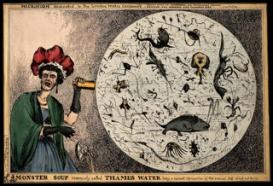Debolina’s project, “Contagion in the Cultural Imagination of Victorian England” looked at disease as a form, and argued that for disease to attain its ubiquitous status in the cultural imagination of Victorian England, it was crucial that disease operated both in its real capacity as a historical phenomenon and as a literary metaphor that could be appropriated into various other discourses. Debolina Dey's dissertation looked at contagion as an expression of anxiety—rather than locating disease only within the contemporary debates about etiology, and how this anxiety is framed within the larger framework of Victorian politics of reform. Debolina’s take on contagion was informed by both its contemporary amorphousness and how then this amorphousness is appropriated by the discourse of reform and public health. Although this dissertation looks at historical legislations like the New Poor Law, the Public Health Act, and the Contagious Diseases Acts—Debolina’s primary interest in contagion was through the adjectival—how contagion from becoming a noun becomes a powerful adjective that then qualifies certain sections of population as pathological. She looked at “contagion” from its status as illness to its ability to classify subjects through this metaphorical potency, so that in the cultural imagination of Victorian England it could signify either cholera, fever, or syphilis—but more importantly the word also carried strong connotations of immorality, idleness, and unproductivity.
Debolina’s interest in looking at the close contiguity of reform, charity, and disease is to interrogate how the classification of disease implied more than just the nosological—for example, cleanliness acquired a certain moral vantage point in the moral economy of victorian domesticity, or that the difference between the poor and paupers was their "deserving" or "undeserving" status. As a student of literature, her dissertation project was interested in these adjectives, the construction of morality, but at the same time was framed around historical legislation that contribute to these classfications. The primary objective of her dissertation was to see how the Victorian preoccupation with the metaphor of "contagion" was both historical and a result of manoeuvring that historicity in a way that it came to signify a polarisation between what was considered as wanted versus the unwanted, productive versus unproductive, or clean versus unclean. Debolina’s dissertation then, looked at the construction of “contagious” as an ideological category in Victorian England, by creating social and moral norms—resulting from the historical materiality of disease in the nineteenth as well as through its literary potency as a metaphor.
Debolina's thesis drew from the current field of the social history of medicine and looked at the way the use of the word "contagion" defined Victorian politics. She mainly did this through an interdisciplinary approach—tracing how the word "contagion" was used to construct Victorian social norms—in legal reports that led to the three main laws viz New Poor Law, Public Health Act, and Contagious Diseases Acts, in popular literature written by women such as conduct book manuals and pamphlets, and in popular novels of the time including Charles Dickens' Bleak House and Elizabeth Gaskell’s Mary Barton. Although Debolina’s thesis was historically rooted and thematically organized around the legal reports and the laws, she looked at the afterlife of these laws in pamphlets and novels. She also compared legal reports and popular novels of the same time to see how differently the connotations of "contagion" were even within the same period. Her thesis kept "contagion" as its thematic tool of questioning the construction of Victorian social norms and considered how these changed over three decades.

